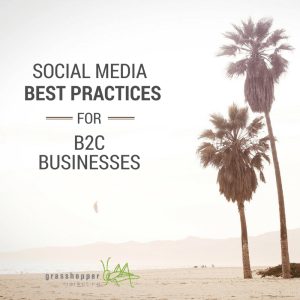16 Jan Social Media Best Practices for B2C Businesses
 A typical consumer perspective on Social Media
A typical consumer perspective on Social Media
Response to a lead generation campaign piece: “I got your card in the mail. I just found your Facebook page, so now that I know you’re real, I wanted to reach out and learn more about your company.”
This illustrates the growing perception of the importance of social media, even in the area of determining organizational legitimacy. The statement is misguided in the idea that a social media presence is necessarily definitive, but the writer’s perception is very real and becoming less uncommon. Organizations do well to respect the growing power and pervasiveness of this new, decentralized way of communication.
Summary of Social Media
Social Media turns the whole world into one neighborhood. It’s NOT about advertising or promoting a product or service. It’s about using technology to expand a word-of-mouth network, unbound by physical location, and to make it more effective and efficiently viral.
People join social media to be connected to their friends, family and colleagues. We’re all just playing in that same same sandbox, and organizations that attempt to dominate the social media experience (even one centered within their own sphere) will feel growing pressure to act right or leave (the sandbox).
Here are several directives to help guide organizations toward acting right in social media to engage positively their audiences while minimizing negative consequences when dealing with an less than predictable public.
Social Media best practices
- Publish a clear posting policy. State what is and is not allowed. Then back it up with consistent, judicial management.
- Answer anyone with legitimate questions or concerns
- Don’t use auto post tools (this can backfire in relation to breaking news)
- Monitor all mentions of brand
- Facebook response time = 2 hours, Twitter = 30 minutes
- Do NOT delete comments unless they clearly violate posting policy, and make sure to post reference to the specific policy violated.
- Be very selective about what you post. All posts must provide some benefit or value.
- Do not post more than 1 time per day (unless breaking news)
- Keep abreast of social media industry trends through regular use of pubs like Mashable
- Pay attention to most popular content
- Act as an agnostic gate keeper (not a biased dictator)
Social Media conversion tactics
- Explicit calls-to-action (make instructions dummy proof)
- Do not use CTAs too often
- Make every piece of content sharable (utilize AddThis tool)
- Peak engagement phase is immediately after someone takes action (ask for follow up sharing of what they did)
- Replicate all requests within Facebook (use CMS API tech). People usually want to stay in Facebook. However, also give them the option of going to your website (for security perceptions).
- Answer/Thank everyone that acts or asks a question (this can be automated)
- Monitor with TweetDeck or Google Alerts (free) or purchase social CRM (SmallAct or SpredFast)
- Facebook ads can be targeted (and you can set it to be charged only when clicked, similar to PPC advertising)
- Close the loop: Tell users what their actions meant (once campaigns are finished)
- Track and report on actions that allow you to make effective adjustments
- Make “it” about the user (put things from their perspective)
- Where applicable, target local subsets of users with content specific to that audience
Twitter vs Facebook
Use Twitter for @replies (not unilateral news, news, news from your company). Converse with others.
Facebook is more action oriented, to engage your community. If a new website platform is an option, it should support CMS API technology for Facebook and other used social media tools (to embed forms into social media platforms, while still running within internal website environment, so user does not have to leave the social site to complete action).
Remember that Like and Follow are the START of a social media relationship, not the end, or the goal, which is rather a growing group of brand evangelists and informed customers.
Social Media Directives
Social Media goals to track
- Advocacy
- Sales
- Customer Service
- Brand sentiment improvement
Social Media content should be:
- Relevant
- Interesting
- Concise
- Responsive
- Provide value
Social Media tactics
- Fun contests
- Opinion polls
- Listen and act upon post feedback
- Answer all legit questions
- Show ways to make a difference
Social Media calls-to-action
- Sales
- Take action
- Form
- Answer question
- RSVP event
Brand Sentiment notes
- 53% of people on Twitter recommend companies and/or products in their Tweets, with 48% of them delivering on their intention to buy the product or to donate.(ROI Research for Performance, June 2010)
- The average consumer mentions specific brands over 90 times per week in conversations with friends, family, and co-workers.(Keller Fay, WOMMA, 2010)
- Consumer reviews are nearly 12 times more trusted than direct company recommendations, according to a survey of US mom Internet users by online video review site EXPO.(eMarketer, February 2010)
- In a study conducted by social networking site myYearbook, 81 percent of respondents said they’d received advice from friends and followers relating to a product purchase through a social site; 74 percent of those who received such advice found it to be influential in their decision.
Brand Sentiment measurement tools
- Socialmention.com - perhaps one of the most useful free social search tools. Great controls and metrics for setting benchmarks.
- Wordle.net - create a word cloud to give a visual representation of your social conversation. Add URL, feed or paste text.
